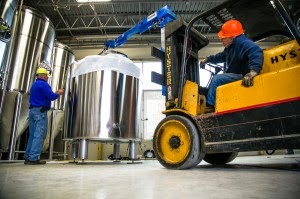This is the "Brewer's Corner" piece as written by Matt from Big Ditch which can be found within the inaugural issue of WNY Craft Beer Magazine. The magazine is currently available at great bars, breweries, and other local beer meccas around town. (Note: this edit is a slightly different edit found in the magazine article, but the points are the same.) Enjoy!
*****
When the Brewhound asked me to write a column on quality control in craft breweries, particularly from the perspective of a startup Buffalo brewery, and particularly in the context of Brewer Association director Paul Gatza’s comments at this year’s Craft Brewers Conference regarding substandard beer from new brewers (his words to these breweries: “Don’t f#%k it up!”), I was admittedly excited. (note: here are some slightly more in depth comments from Mitch Steele, brewmaster at Stone Brewing Company.)
Having spent most of my career in the biotech industry, quality has been a primary focus of mine for the last ten years. What might surprise many beer drinkers is how the term “quality” is used by most industries. Most craft beer drinkers equate quality with great tasting beer, and in many ways, they’re correct. But quality in the brewing industry, as it is in many other industries, is actually synonymous with consistency.
Making a great beer requires two things: a good recipe, including the use of quality ingredients, and a good process. Even if you are lucky enough to make a great beer once, you need control to keep it that way. Just getting the process right every few batches is not going to cut it. As a brewer, you have to know the important inputs and how they will affect the output. An easy example is temperature control during fermentation. A beer fermented at 50 degrees and 90 degrees will never taste the same. This is a variable you need to not only measure every time, but also know the allowable tolerances of in order to get the same beer every batch.
In addition, consider the fact that beer is made from minimally processed, seasonally varying ingredients (barley, hops, water). Then consider the fact that beer is an active biological system and you begin to get an understanding of the difficulties in controlling the consistency of beer.
Big Ditch Brewing will have an on-site quality lab, which we will use to measure critical inputs and perform tests on our beers before we release them. We also have plans to initiate a sensory analysis panel to ensure our beers meet intended targets for appearance, aroma, taste, mouthfeel, and other critical attributes. Do we need this stuff to make a good beer? No. Do we need it to consistently make good beer? Time will tell.

Photo by Don Burns
Gatza’s words were intended as a wake-up call to new brewers, and he was right to offer them. Despite craft being a relatively new player in the American beer scene, it has already experienced a few minor regressions, partially due instances of poor quality product. Frankly, as a new brewery that has not produced a single commercial beer yet, Gatza’s words scare the hell out of me. Opening a brewery is a labor of love, and we have burned the midnight oil scrutinizing every detail in the process of opening, but nothing consumes my thoughts more than what that first beer will taste like when it’s ready, and whether it will be as great as I’ve imagined.
However, I also know that the best brewers always want their beer to be better and continually strive for improvement. I expect we’ll do the same.
Brewer's corner: Craft quality control
Posted by
Matt
Monday, June 23, 2014
Subscribe to:
Post Comments
(
Atom
)
0 comments :
Post a Comment